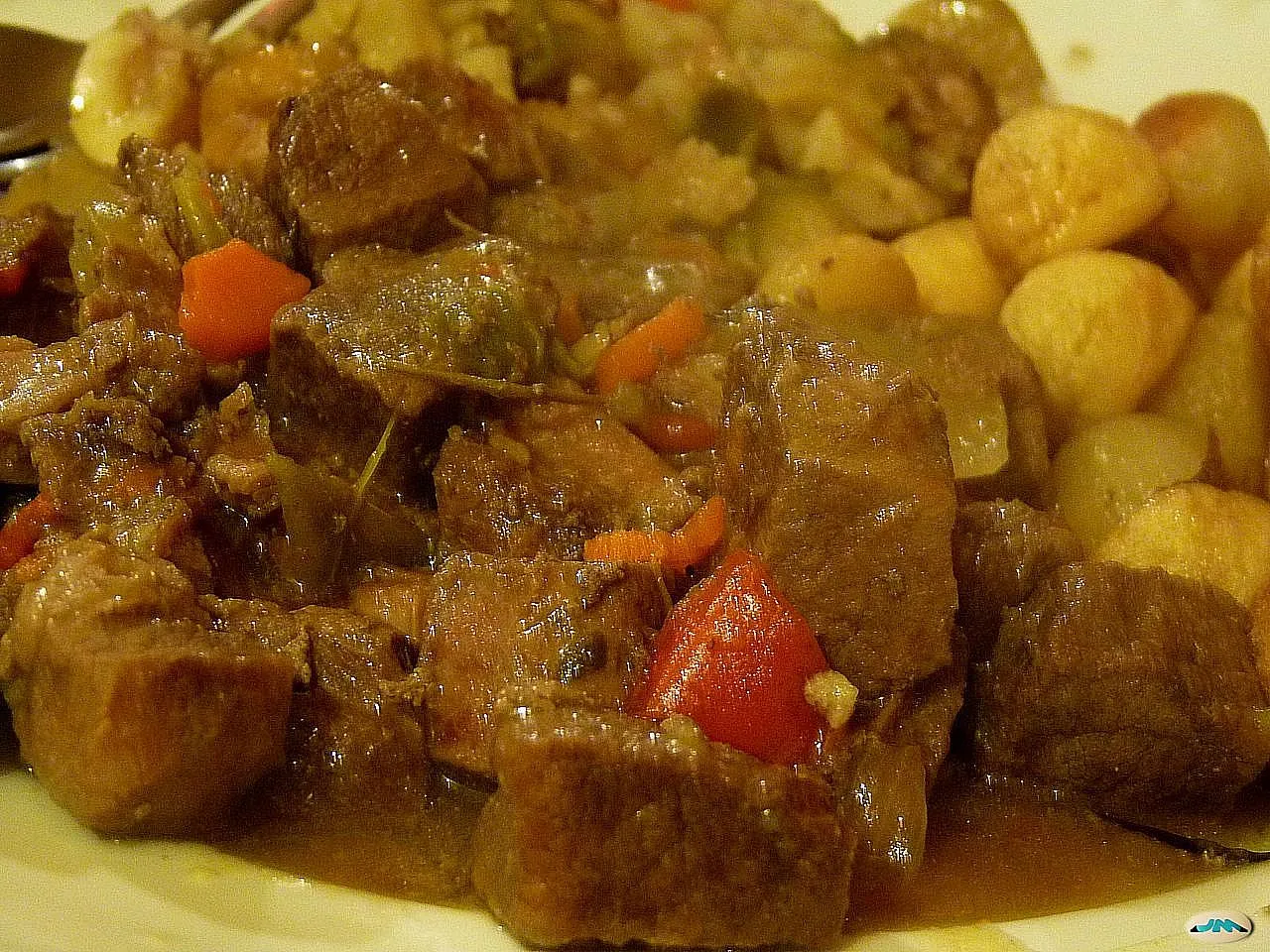The Best Fluffy Pancakes recipe you will fall in love with. Full of tips and tricks to help you make the best pancakes.
If you’re craving a rich, savory, and comforting dish, Beef Caldereta is the perfect choice. This classic Filipino beef stew is known for its tender chunks of beef simmered slowly in a flavorful tomato-based sauce, enhanced with liver spread, cheese, and a colorful mix of vegetables. A staple at Filipino celebrations and family dinners, Caldereta offers the ideal balance of hearty flavors and creamy goodness in every bite.
In this step-by-step guide, you’ll learn how to cook Beef Caldereta at home—from selecting the best beef cut to achieving that thick, flavorful sauce that makes this dish truly unforgettable. Whether you’re new to Filipino cuisine or simply looking to perfect your own recipe, this easy and authentic version will help you create a comforting meal your family will love.
What Is Beef Caldereta? (Filipino Stew Overview)
Origins of Beef Caldereta in Filipino Cuisine
Beef Caldereta, also known as Kalderetang Baka, is a beloved Filipino stew that traces its roots back to Spanish colonial times in the Philippines. The word caldereta comes from the Spanish word caldera, meaning “cauldron,” symbolizing a dish that’s slow-cooked to perfection. Over time, Filipinos added their own twist—infusing local flavors and ingredients such as liver spread, soy sauce, and cheese—turning this Spanish-inspired dish into a true Filipino comfort food that’s often served during special occasions, fiestas, and family gatherings.

What Makes Caldereta Different from Mechado and Afritada
Although Caldereta, Mechado, and Afritada share similarities as tomato-based Filipino stews, each has its own unique flavor profile. Caldereta is the richest of the three, known for its creamy and slightly spicy sauce made with liver spread or pâté. Mechado uses soy sauce and calamansi, giving it a tangier taste, while Afritada tends to be lighter and sweeter. What truly sets Beef Caldereta apart is its depth of flavor—a combination of savory, creamy, and mildly spicy notes that make it irresistible.
Key Ingredients That Define a Classic Caldereta
A traditional Beef Caldereta recipe is built on layers of bold flavors. The main ingredients include tender beef chunks (usually beef chuck or short ribs), tomato sauce, liver spread, garlic, onion, bell peppers, potatoes, and carrots. Optional additions like green olives, cheddar cheese, or red chili add richness and heat. Each ingredient plays a vital role in achieving the signature thick and flavorful sauce that makes Caldereta so comforting.
Why Filipinos Love This Savory Beef Stew
For many Filipinos, Beef Caldereta isn’t just food—it’s a taste of home. It’s the kind of dish that brings families together around the dinner table. The slow-cooked beef melts in your mouth, while the sauce—rich, creamy, and full of umami—pairs perfectly with steamed white rice. Whether served at a festive celebration or on a quiet Sunday lunch, Caldereta always delivers warmth, nostalgia, and satisfaction.
Ingredients and Tools You’ll Need
Before you start cooking, it’s important to gather all the ingredients and tools you’ll need to make a delicious and authentic Beef Caldereta. This ensures a smooth cooking process and helps you achieve the perfect balance of flavors in every bite.
Main Ingredients for Authentic Beef Caldereta
To make Beef Caldereta for about 4 to 6 servings, you’ll need:
- 2 lbs (900 g) beef chuck or short ribs, cut into cubes
- 2 tablespoons cooking oil (vegetable or canola)
- 1 medium onion, finely chopped
- 4 cloves garlic, minced
- 1 cup tomato sauce
- 2 tablespoons tomato paste
- 3 cups beef broth or water
- 1/3 cup liver spread (or pâté, for creaminess and depth)
- 2 medium potatoes, peeled and cubed
- 1 large carrot, sliced into rounds
- 1 red bell pepper, sliced into strips
- 1 green bell pepper, sliced into strips
- 1/4 cup green olives (optional but traditional)
- 1/2 cup grated cheddar cheese (for a creamy finish)
- 2 tablespoons soy sauce
- 1 teaspoon salt (adjust to taste)
- 1/2 teaspoon ground black pepper
- 2 bay leaves
- 1 small red chili or 1/2 teaspoon chili flakes (optional, for a spicy kick)
Optional additions:
- 1 tablespoon vinegar (for a tangy flavor)
- 1/2 cup green peas (adds texture and color)
Optional Ingredient Substitutions
- Liver spread substitute: Use 1 tablespoon peanut butter or 1/4 cup chicken liver purée if unavailable.
- Cheese substitute: You can replace cheddar with quick-melt cheese or cream cheese for a smoother texture.
- Beef cut alternative: Try beef brisket or stew meat for a more tender and flavorful result.
Essential Kitchen Tools and Utensils
To make cooking Beef Caldereta easy and efficient, prepare these kitchen essentials:
- Large pot or Dutch oven – for simmering the stew evenly.
- Wooden spoon or heat-resistant spatula – for stirring without damaging your cookware.
- Sharp chef’s knife – for cutting beef and vegetables precisely.
- Cutting board – to keep your prep area organized.
- Measuring cups and spoons – to ensure accurate proportions.
- Ladle – for serving the caldereta and portioning sauce.
- Mixing bowl – for marinating the beef or prepping ingredients.
Ingredient Preparation Tips
- Cut the beef into equal-sized cubes to ensure even cooking.
- Soak the potatoes in water after cutting to prevent discoloration.
- Chop vegetables right before adding them to maintain freshness and texture.
- Always taste and adjust seasoning at the end—Caldereta should be rich, savory, and slightly creamy.
Step-by-Step Recipe Instructions
This step-by-step guide will show you how to cook the best Beef Caldereta — rich, flavorful, and perfectly tender. Follow each stage carefully to achieve the ideal balance of spices, creaminess, and texture that makes this Filipino stew truly special.
Step 1 – Prepare and Marinate the Beef
Start by preparing your 2 lbs (900 g) beef chuck or short ribs. Cut the meat into medium-sized cubes (about 1½ inches each) to help them cook evenly and stay tender.
In a mixing bowl, combine:
- 2 tablespoons soy sauce
- 1 teaspoon ground black pepper
- 2 cloves garlic, minced
- 1 tablespoon vinegar (optional)
Add the beef cubes and marinate for at least 30 minutes (or up to 2 hours in the refrigerator). This helps infuse the meat with flavor and slightly tenderizes it before cooking.
💡 Tip: For deeper flavor, you can marinate overnight if time allows.
Step 2 – Brown the Beef for Extra Flavor
Heat 2 tablespoons cooking oil in a large pot or Dutch oven over medium-high heat. Once hot, add the marinated beef pieces and sear them in batches until browned on all sides.
Don’t overcrowd the pot — sear in two or three batches to avoid steaming the meat. This browning step enhances the rich, savory flavor of your Beef Caldereta.
After searing, remove the beef and set it aside on a plate.
💡 Tip: Don’t discard the brown bits stuck to the bottom — they’ll add depth to your sauce later.
Step 3 – Sauté the Aromatics and Build the Sauce
In the same pot, add a little more oil if needed. Lower the heat to medium, then sauté:
- 1 medium onion, chopped
- 2 cloves garlic, minced
Cook until the onion turns translucent and fragrant (about 2 minutes). Then, stir in:
- 1 cup tomato sauce
- 2 tablespoons tomato paste
- 2 bay leaves
Mix well, scraping the browned bits from the bottom of the pot.
Add back the browned beef, then pour in 3 cups beef broth or water. Stir gently to combine.
Cover and bring to a boil, then lower the heat and simmer for 45–60 minutes, or until the beef becomes fork-tender. Stir occasionally to prevent sticking.
💡 Tip: If the liquid reduces too much, add a bit more broth or water as needed.
Step 4 – Add the Vegetables and Liver Spread
Once the beef is tender, it’s time to add the vegetables and creamy elements that define Caldereta.
Add:
- 2 medium potatoes, cubed
- 1 large carrot, sliced
- 1/3 cup liver spread (or pâté)
Stir well and simmer for 10–12 minutes, until the potatoes and carrots begin to soften.
Next, add:
- 1 red bell pepper, sliced
- 1 green bell pepper, sliced
- 1/4 cup green olives (optional)
Cook for another 5 minutes, until the bell peppers are tender but not mushy.
Step 5 – Add Cheese and Adjust the Seasoning
Finally, stir in 1/2 cup grated cheddar cheese to create a smooth and creamy sauce.
Taste and adjust seasoning with salt and pepper as needed. If you prefer a spicy kick, you can add 1 small chili or 1/2 teaspoon chili flakes.
Simmer everything together for another 3–5 minutes, allowing the sauce to thicken beautifully.
Your Beef Caldereta should now have a rich, thick, and slightly creamy sauce that coats the tender beef and vegetables perfectly.
💡 Tip: Let the caldereta rest for 10 minutes before serving to let the flavors meld.
Step 6 – Serve and Enjoy
Serve your Beef Caldereta warm with steamed white rice, garlic fried rice, or pandesal on the side.
Garnish with a few grated cheese shavings or fresh parsley for an appetizing presentation.
Enjoy this comforting and flavorful dish with family or friends—it’s the kind of meal that always tastes like home.
Tips for Success and Flavor Variations
Whether you’re making Beef Caldereta for the first time or looking to perfect your family recipe, a few expert techniques and creative ideas can take your dish from good to truly exceptional. These tips will help you achieve tender beef, a rich sauce, and flavorful twists that suit every taste.
How to Make the Beef Extra Tender
One of the keys to an unforgettable Beef Caldereta is ensuring the beef is melt-in-your-mouth tender. Here’s how to do it right:
- Choose the right cut: Opt for beef chuck, short ribs, or brisket—these cuts have enough fat and connective tissue to stay moist during long simmering.
- Marinate before cooking: Marinating in soy sauce, garlic, and pepper infuses the beef with flavor and helps break down its fibers.
- Cook low and slow: Simmer the stew over low heat for 1 to 1½ hours, or until the beef easily breaks apart with a fork.
- Use a pressure cooker or Instant Pot: For a faster option, pressure-cook the beef for about 30 minutes before adding the vegetables.
💡 Pro tip: Avoid boiling the stew too rapidly—it can make the beef tough and the sauce thin.
Flavor Boosters and Secret Ingredients
Authentic Filipino Beef Caldereta is known for its deep, savory, and creamy flavor. To elevate it, try adding a few special touches:
- Liver spread or pâté: This is the traditional secret ingredient that gives Caldereta its distinctive richness.
- Cheese: A small amount of grated cheddar or quick-melt cheese thickens the sauce and adds a subtle creaminess.
- Red wine or beer: Adding ¼ cup of red wine or light beer during simmering enhances depth and aroma.
- Chili flakes or fresh chili: For a spicy Caldereta, add chili near the end of cooking for a nice heat balance.
- Bay leaves and paprika: These spices complement the tomato base and give the sauce a warm, earthy flavor.
💡 Pro tip: Add the cheese and liver spread toward the end of cooking to avoid curdling or burning.
Creative Variations of Caldereta
While the classic Beef Caldereta is the most popular, you can explore a few exciting variations for different occasions:
- Pork Caldereta: A quicker, more budget-friendly version that’s equally flavorful.
- Chicken Caldereta: Lighter and ideal for weeknight dinners; reduce cooking time to about 40 minutes.
- Goat Caldereta (Kalderetang Kambing): A traditional Filipino favorite often served during celebrations, known for its gamey flavor and rich sauce.
- Cheesy Caldereta: Add extra cheese and a splash of cream for a creamier, restaurant-style dish.
- Spicy Caldereta: Use bird’s eye chili or hot sauce for a bolder version that pairs perfectly with garlic rice.
💡 Pro tip: No matter the protein, the key to a great Caldereta is balancing the savory tomato base with a touch of sweetness and spice.
Common Mistakes to Avoid
Even seasoned cooks can make small missteps that affect the final result. Here are a few things to watch out for:
- Skipping the browning step: Searing the beef locks in juices and adds rich flavor.
- Overcooking vegetables: Add potatoes and carrots only when the beef is nearly tender to prevent them from turning mushy.
- Adding too much liquid: Caldereta should be thick and saucy, not watery. Simmer uncovered for a few minutes if needed to reduce the sauce.
- Neglecting to taste as you go: Adjust seasoning throughout cooking—don’t wait until the end.
- Using lean beef cuts: They can dry out during long cooking. Always choose well-marbled meat.
💡 Pro tip: If your sauce turns out too thin, stir in a tablespoon of tomato paste or cheese to thicken it.
Serving, Storage, and Reheating Tips
Once your Beef Caldereta is cooked to perfection — tender beef, rich tomato sauce, and creamy texture — it’s time to serve and enjoy it the Filipino way. This hearty dish tastes even better the next day, so knowing how to serve, store, and reheat it properly will make all the difference.
How to Serve Beef Caldereta
Beef Caldereta is best served warm and fresh from the pot. It’s a hearty main course that pairs beautifully with simple sides that soak up its flavorful sauce.
Here are a few serving ideas:
- With steamed white rice: The most traditional way to enjoy Caldereta. The rice balances the bold, savory flavors of the stew.
- With garlic fried rice (sinangag): Adds extra flavor and crunch to your meal.
- With pandesal or crusty bread: Perfect for dipping into the thick, creamy sauce.
- As part of a Filipino feast: Pair with classic favorites like Lumpiang Shanghai, Pancit Canton, or Chicken Adobo for a complete meal.
💡 Pro tip: Before serving, sprinkle a bit of grated cheese on top and garnish with fresh parsley or sliced red bell pepper for a colorful and appetizing finish.
Garnishing and Presentation Ideas
Presentation makes your Beef Caldereta even more irresistible. Try these simple touches:
- Cheesy topping: Add a thin layer of melted cheddar or quick-melt cheese on top before serving.
- Colorful garnish: Use fresh herbs, a few green olives, or a drizzle of cream for restaurant-style appeal.
- Serve in a clay pot or deep serving bowl: This keeps the stew warm and enhances the rustic, homey feel of the dish.
💡 Pro tip: For festive occasions, serve Caldereta in a large platter surrounded by roasted vegetables or rice for a beautiful centerpiece.
How to Store Leftover Beef Caldereta
If you have leftovers (lucky you!), proper storage will help keep the flavors intact and the beef tender:
- Refrigerate: Allow the Caldereta to cool to room temperature, then transfer it to an airtight container. Store in the fridge for up to 3–4 days.
- Freeze: For longer storage, place in freezer-safe containers or zip-lock bags. It can last up to 2 months in the freezer.
- Avoid storing in metal containers as the tomato sauce can react with metal and alter the taste.
💡 Pro tip: Label your container with the date so you know when it’s time to enjoy it again.
How to Reheat Without Losing Flavor
Reheating Beef Caldereta correctly ensures that the sauce remains creamy and the beef stays tender:
- Stovetop method (recommended):
Transfer the Caldereta to a pot and reheat over low to medium heat. Add 2–3 tablespoons of water or broth if the sauce has thickened too much. Stir occasionally until heated through. - Microwave method:
Place in a microwave-safe bowl, cover loosely, and heat in 1-minute intervals, stirring in between to ensure even heating. - Frozen Caldereta:
Thaw overnight in the refrigerator before reheating.
💡 Pro tip: Caldereta often tastes even better the next day, as the flavors deepen overnight — a true bonus of this Filipino favorite!
Pairing Ideas for a Complete Filipino Meal
Round out your meal with other Filipino classics that complement Beef Caldereta’s rich and savory profile:
- Side dishes: Garlic rice, ensaladang mangga (green mango salad), or buttered corn.
- Appetizers: Lumpiang Shanghai (Filipino spring rolls) or ukoy (shrimp fritters).
- Drinks: Calamansi juice, iced tea, or San Miguel beer for an authentic experience.
- Desserts: Leche flan, ube halaya, or buko salad for a sweet finish.
💡 Pro tip: Serve Caldereta with a light salad or tropical fruit dessert to balance its richness.
Final Note
Beef Caldereta is more than just a stew—it’s a celebration of Filipino flavors and family traditions. With the right ingredients, a bit of patience, and these practical tips, you can enjoy this rich, hearty dish any day of the week — and savor the warmth and comfort it brings with every bite.






Thanks for this tremendous post, I am glad I observed this website on yahoo.